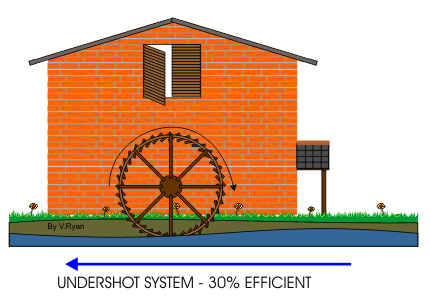During the 18th century up till the first half of the 19th century, the world was dominated by the Industrial Revolution. By this time the world's population increased over 6-fold while the world's average per capita income increased over 10-fold. This lead to great advances in technology.
Started in Britain, there was a change in the previously manual labour and the use of animals, to machine-based manufacturing. Textile industries were among the first to use machines, where then moved on to the development of iron and refined coal. Canals, railways and improved roads were introduced as a better usage of transport.
During the early years of the Industrial Revolution the water wheel was the main form of power. Like the example below, the wheel is being rotated by the river/stream. As the wheel rotates the shaft running through its centre will be used to power machines through a range of pulleys.
 Later on in 1775, the Scottish mechanical engineer James Watt had invented the steam engine which improved the power, efficiency and cost-effectiveness of previous engines. Due to lack of finance, Watt joined Matthew Boulton to create a firm and was then a wealthy successful man. The steam engine made a huge impact in this era as it was used in the production industries.
The image shows the model on which Watt used to test his designs.
Later on in 1775, the Scottish mechanical engineer James Watt had invented the steam engine which improved the power, efficiency and cost-effectiveness of previous engines. Due to lack of finance, Watt joined Matthew Boulton to create a firm and was then a wealthy successful man. The steam engine made a huge impact in this era as it was used in the production industries.
The image shows the model on which Watt used to test his designs.
As seen in the image below, children used to work with machines by risking to get injured easily and this also helped to drive down the price of cotton production.
 In 1819, Alexandrina Victoria was born who nineteen years later in 1838 she was coronated the Queen of Great Britain. Queen Victoria made an impact in the Arts & Crafts movement later in the 19th century.
In 1819, Alexandrina Victoria was born who nineteen years later in 1838 she was coronated the Queen of Great Britain. Queen Victoria made an impact in the Arts & Crafts movement later in the 19th century.
In 1843 the Victorian era had already began in its early stages whereas in this same year the famous novel 'A Christmas Carol' by Charles Dickens was published. It was a period where there was a strong nostalgia for old Christmas traditions and an initiation of new practices like the Christmas tree. This tale had also be criticised as an indicment of the 19th century industrial capitalism.
References:
Ryan. V, 2009. The Water Wheel. [image online] Available at: http://www.technologystudent.com/energy1/wtrwhl1.htm [Accessed 22nd October 2013]
atepperm, 2012. Queen Victoria. [image online] Available at: http://pointsadhsblog.wordpress.com/2012/04/04/victorian-women-on-drugs-part-1-queen-victoria/ [Accessed 22nd October 2013]
princtone, n.d. Industrial Revolution. [online] Available at:
http://www.princeton.edu/~achaney/tmve/wiki100k/docs/Industrial_Revolution.html [Accessed 22nd October 2013]
Megan Popow, n.d. Inequality Caused By The Industrial Revolution. [images online] Available at:
http://www.personal.psu.edu/mep229/Assignment6.html [Accessed 22nd October 2013]
Mary Bellis, 2013. Captivity Of Steam. [image online] Available at:
http://inventors.about.com/od/wstartinventors/a/JamesWatt.htm [Accessed 22nd October 2013]
Gutenberg, n.d. A Christmas Carol. [online] Available at: http://www.gutenberg.org/files/46/46-h/46-h.htm [Accessed 22nd October 2013]
During the early years of the Industrial Revolution the water wheel was the main form of power. Like the example below, the wheel is being rotated by the river/stream. As the wheel rotates the shaft running through its centre will be used to power machines through a range of pulleys.
In 1843 the Victorian era had already began in its early stages whereas in this same year the famous novel 'A Christmas Carol' by Charles Dickens was published. It was a period where there was a strong nostalgia for old Christmas traditions and an initiation of new practices like the Christmas tree. This tale had also be criticised as an indicment of the 19th century industrial capitalism.
Gutenberg, n.d. A Christmas Carol. [online] Available at: http://www.gutenberg.org/files/46/46-h/46-h.htm [Accessed 22nd October 2013]




No comments:
Post a Comment